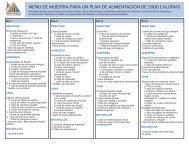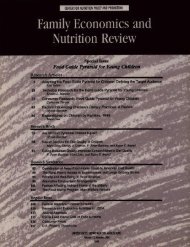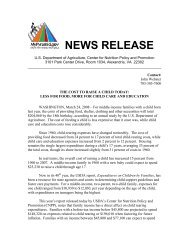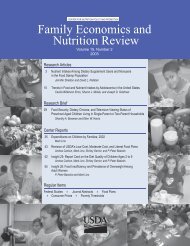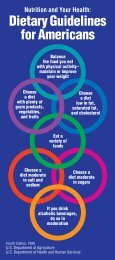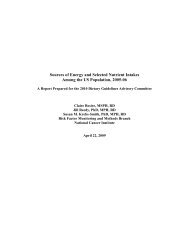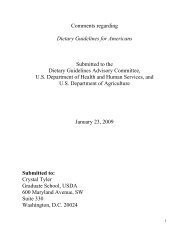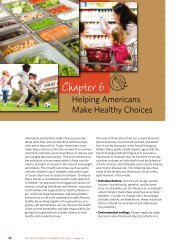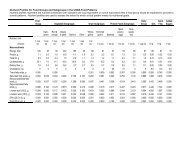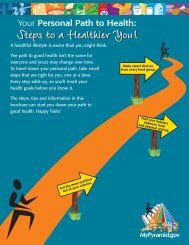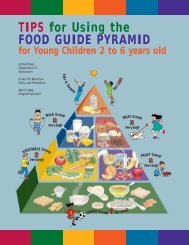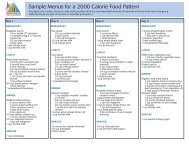Elderly Nutrition - Center for Nutrition Policy and Promotion - US ...
Elderly Nutrition - Center for Nutrition Policy and Promotion - US ...
Elderly Nutrition - Center for Nutrition Policy and Promotion - US ...
You also want an ePaper? Increase the reach of your titles
YUMPU automatically turns print PDFs into web optimized ePapers that Google loves.
her daughter <strong>and</strong> husb<strong>and</strong>, who died<br />
during the study; one, with her elderly<br />
boyfriend; <strong>and</strong> one, with her teenaged<br />
gr<strong>and</strong>son. Two received both food<br />
stamps <strong>and</strong> home-delivered meals.<br />
Three of the elders received homedelivered<br />
meals only—one, not because<br />
she needed them, but because she<br />
helped deliver these meals. Of the<br />
nine elders, only two participated in<br />
congregate meals <strong>and</strong> received food<br />
from food pantries; two did not<br />
participate in any food programs.<br />
Monthly incomes of the elderly<br />
participants ranged from $400 to $900,<br />
averaging $738 each month. Six lived<br />
in subsidized housing; all had been<br />
employed most of their lives; two had<br />
not completed high school, five were<br />
high school graduates, <strong>and</strong> two<br />
attended some college.<br />
Each participant was interviewed<br />
weekly by telephone <strong>for</strong> 4 months<br />
(December 2000 to March 2001) by<br />
one of the authors who per<strong>for</strong>med all<br />
of the interviews by using an interview<br />
guide <strong>and</strong> a tape recorder. Participants<br />
were asked about the past week: their<br />
food situation (i.e., how they obtain<br />
their groceries, whether they had any<br />
help with meals, whether they attended<br />
any food programs, or whether they<br />
had problems accessing food), their use<br />
of social networks, frequency of family<br />
contacts, changes in their health or<br />
social support, <strong>and</strong> events of the past<br />
week. Rapport was established quickly<br />
during the telephone conversations,<br />
because the same interviewer had<br />
interviewed each participant twice in<br />
his or her home during the previous<br />
year. The weekly contact helped to<br />
increase rapport further, which is<br />
important <strong>for</strong> gathering this type of<br />
sensitive in<strong>for</strong>mation. In<strong>for</strong>med consent<br />
(to participate <strong>and</strong> to tape record the<br />
telephone interviews) was obtained<br />
in the first interview.<br />
Analysis was ongoing: Each week prior<br />
to the next telephone interview, the<br />
interviewer listened to, took detailed<br />
notes from, <strong>and</strong> analyzed the interview<br />
of the previous week. From this<br />
analysis, the interviewer developed<br />
follow-up questions to probe more fully<br />
<strong>for</strong> emerging issues. Following the final<br />
interviews, these records were further<br />
analyzed, summarized, reviewed, <strong>and</strong><br />
discussed by all three authors.<br />
Results <strong>and</strong> Discussion<br />
Usefulness of the Concurrent<br />
Events Approach <strong>for</strong><br />
Underst<strong>and</strong>ing Social Support<br />
<strong>and</strong> Food Insecurity<br />
As expected, the time-intensive telephone<br />
interviews produced a fuller<br />
underst<strong>and</strong>ing of some issues that<br />
arose in our earlier research with this<br />
population. One finding was the<br />
surprising extent <strong>and</strong> importance of<br />
food exchange as a source of social<br />
<strong>and</strong> food support among elders, a<br />
finding that had not been captured in<br />
the in-depth interviews. For example,<br />
one woman took home-delivered meals<br />
to others in her building <strong>and</strong> sold Avon<br />
products, both of which placed her in<br />
situations where people gave her food<br />
they had received from the homedelivered<br />
meal program, food pantries,<br />
or restaurants. These food gifts, plus<br />
the free home-delivered meals she<br />
received <strong>for</strong> working <strong>for</strong> them, were<br />
important to her food security.<br />
Another woman, with very low mobility,<br />
lived alone <strong>and</strong> relied on her family <strong>for</strong><br />
support. Because this was not always<br />
reliable, this participant became a<br />
member of a food network in her<br />
apartment building <strong>for</strong> seniors. This<br />
network included elaborate food-trade<br />
<strong>and</strong> food-access strategies. For<br />
example, in addition to receiving halfpint<br />
cartons of milk from a neighbor’s<br />
home-delivered meals, this study<br />
participant received food from a woman<br />
who did not use all the food that her<br />
The weekly telephone calls<br />
provided good rapport between<br />
the elderly food-insecure<br />
participants <strong>and</strong> the interviewer<br />
<strong>and</strong> a fuller underst<strong>and</strong>ing of food<br />
insecurity, social support, other<br />
events, <strong>and</strong> experiences among<br />
these elderly participants.<br />
2003 Vol. 15 No. 1 27



